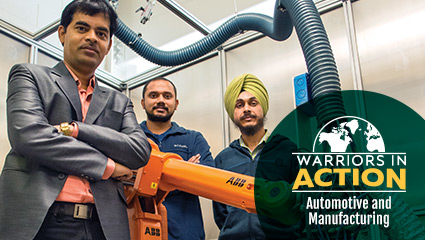Over the coming months, look for stories that feature some of the many Wayne State initiatives and pioneering individuals committed to automotive and manufacturing innovation. This content is part of WSU's Warriors in Action campaign highlighting how Wayne State is making a difference.
 Additive manufacturing, or 3-D printing as it is commonly known, is still a relatively young technology. However, a global industrial shift toward internet technology, sustainability and renewable energy means that additive manufacturing has the potential to significantly change the world.
Additive manufacturing, or 3-D printing as it is commonly known, is still a relatively young technology. However, a global industrial shift toward internet technology, sustainability and renewable energy means that additive manufacturing has the potential to significantly change the world.
Among the researchers seeking to widen the knowledge base of additive manufacturing is Guru Dinda, assistant professor of mechanical engineering at Wayne State University. His lab has developed a 3-D printing process called Laser Metal Deposition (LMD).
In the LMD process, “material addition can be controlled at a pixel level to meet design and functionality requirements,” said Dinda. “The LMD process combines laser cladding with rapid prototyping into a solid freeform fabrication process, which can be used to fabricate porous or solid metallic parts directly from a CAD model.”
A robot-controlled laser beam follows a path generated from the computer-aided design (CAD) model to create a three-dimensional component layer by layer. This substrate-focused laser forms a melt pool, to which metal powders are simultaneously delivered by a specially designed coaxial nozzle.
Dinda and his students have used this LMD system to experiment with a variety of metals in an effort to determine best practices for additive manufacturing methods. According to their research, iron, cobalt, nickel and titanium are among the metals and alloys that can be used in 3-D printing, while others such as aluminum, magnesium, zinc and tin are not yet suitable. Dinda’s team has created a number of stainless steel and superalloy components with LMD.
Additive manufacturing processes such as LMD can be applied to many industries, from biomedicine to aerospace. It can be used for surface coatings as well as remanufacturing, and it uses a fraction of the energy and raw materials necessary with typical factory productions.
However, according to Dinda, “the main advantage of 3-D printing is its potential to make very complex objects — almost any shape one likes — which cannot be fabricated by conventional manufacturing processes.”
Dinda believes additive manufacturing is at least five years away from competing with conventional processes for small-batch production of complex and custom design components, and about 25 years from mass production capabilities. However, the possibilities for 3-D printing are numerous, ranging from the fabrication of organs for patients awaiting transplants to making the idea of living on Mars or the moon feasible. The projected economic and social impact of 3-D printing speaks volumes as to how Dinda’s research plays a critical role in the global development of additive manufacturing.